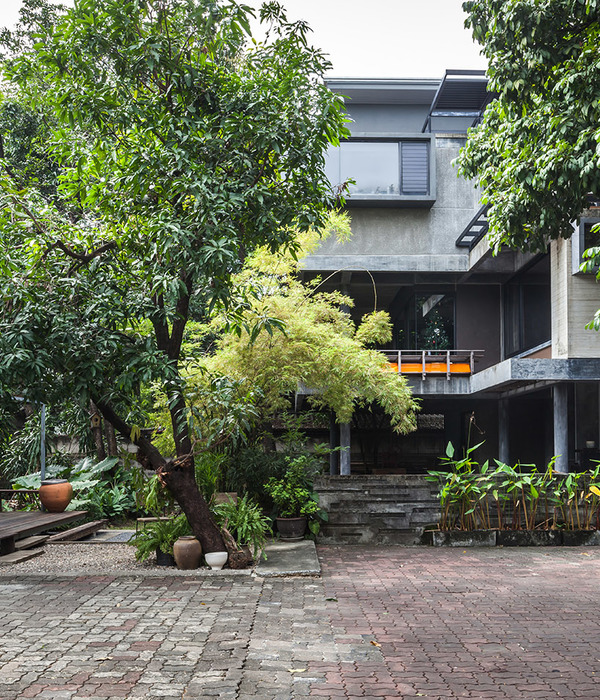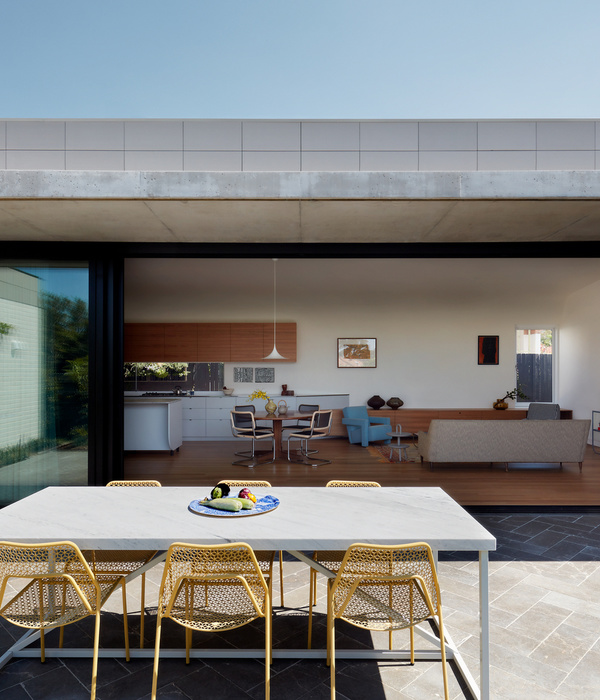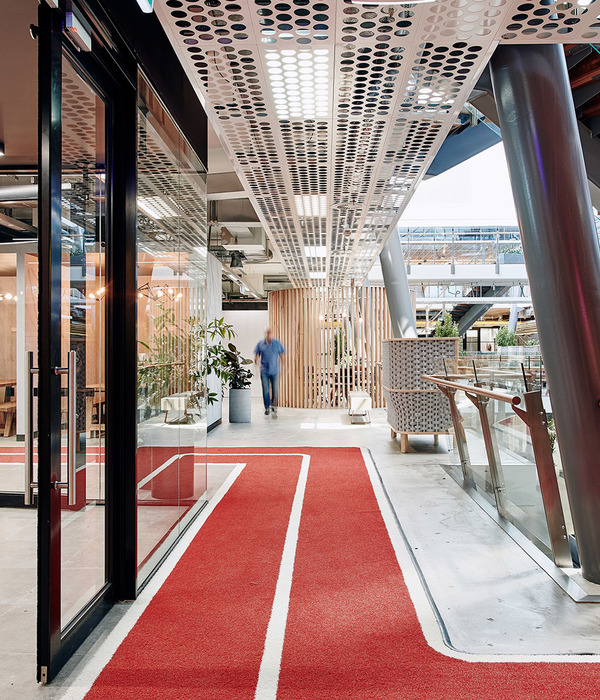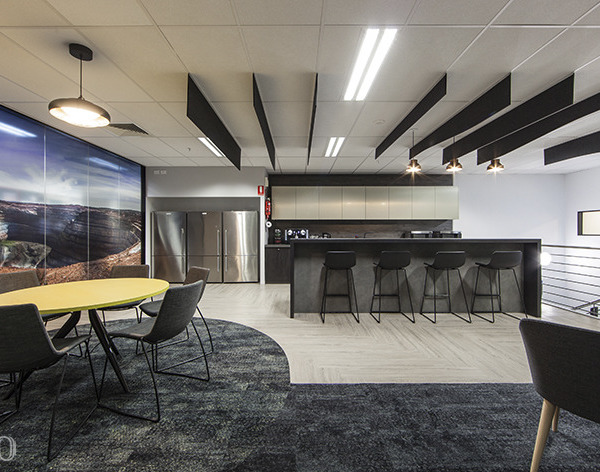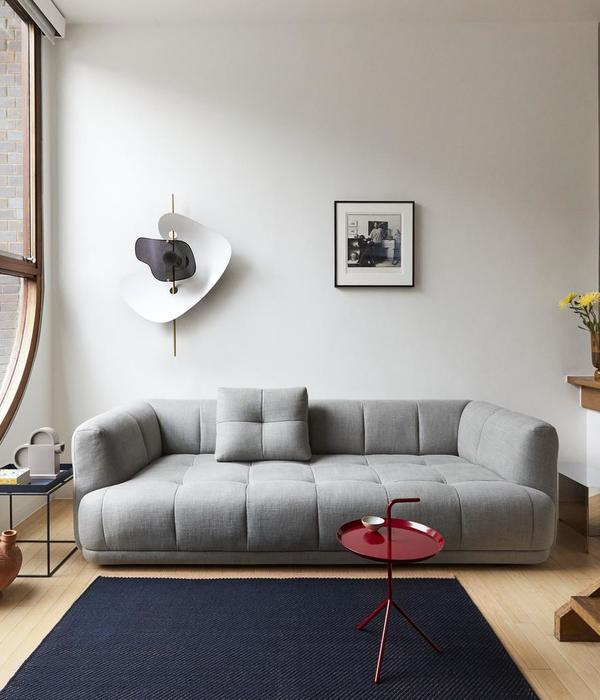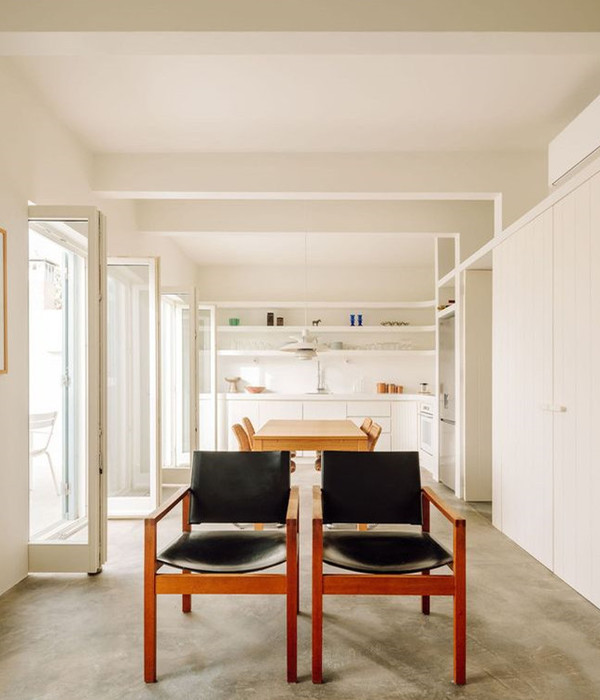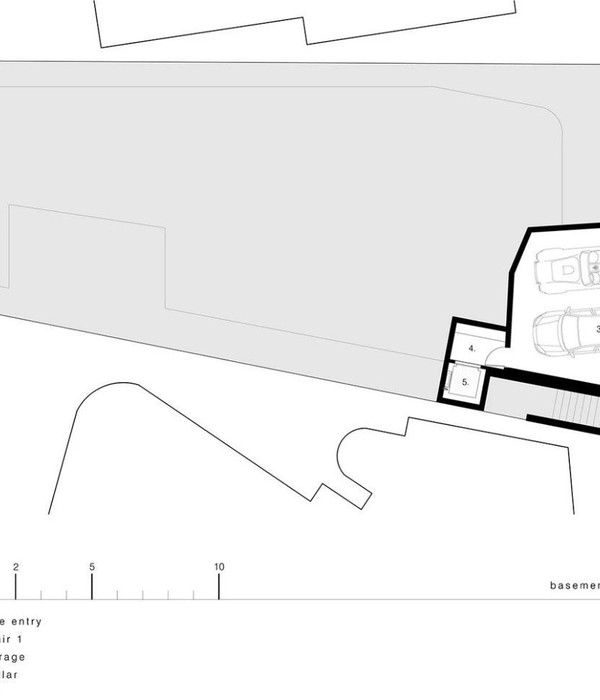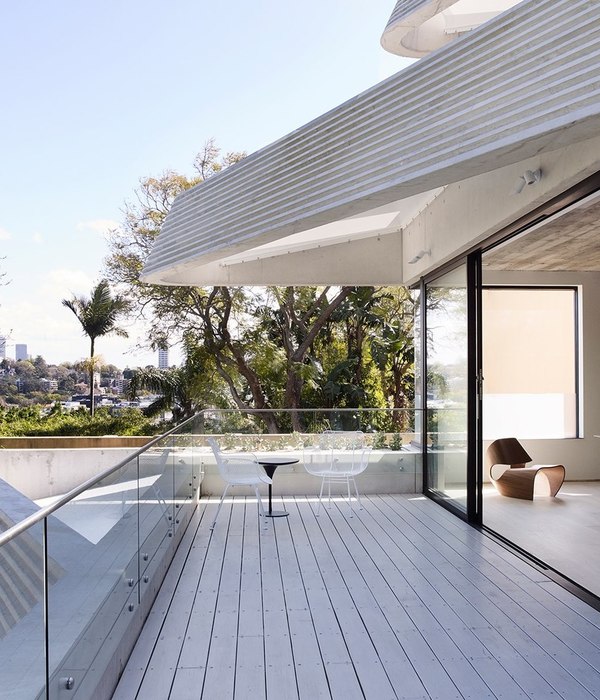“This beautifully detailed design is remarkable for its ability on a central quad to combine green lawn space with rain gardens and systems, which are incredibly hard to merge, and it does it in a comfortable manner. . . It’s going to maintain well. They’ve allowed for tree growth and brought attention to it.”- 2014 Awards Jury
“这个设计完美巧妙,构思细腻,因为它能够把中央的一处方形地块中绿色草坪空间和雨水花园系统完美结合起来,这些事物是很难融合到一起的,而该设计却做到了,并且舒适自然,同时绿地环境得到了维护。设计者考虑到了植物的生长并且对此也给予了足够的重视。”- 2014年奖项评审团
ASLA
Philadelphia, PA |
Andropogon Associates Ltd.
| Client: University of Pennsylvania 更多请至:
Shoemaker Green is a new, 2.75-acre public green at the heart of the University of Pennsylvania’s historic athletics precinct. The project has transformed an underused and under-appreciated corner of the campus into a harmonious merger of people and place, of history and emergence, and of function with high performance. The ecological sophistication and holistic approach to site design is evident in the final form of the work: a profoundly beautiful and fitting campus space.
休梅克绿地是一处新近落成,占地2.75英亩的公共绿地,位于宾夕法尼亚大学历史上著名田径运动场中心区。该项目将校园中一片未得到充分利用的荒废角落改造成了一块高效多功能的绿地,在这里,人与自然、历史与当代和谐完美的融会到一起。在该绿地竣工之后,其设计的生态复杂性和整体分析彰显无遗:美丽动人,心旷神怡的校园空间。
▼Resilient Open Space
Shoemaker Green provides flexible gathering spaces throughout the site and accommodates a multitude of uses, from passive use and outdoor classrooms, to larger events, such as outdoor concerts, graduation, and international events, like the Penn Relays.
弹性灵活的开放空间
休梅克绿地横贯校园中央,可给人们提供灵活的多功能的聚集空间:可供人们能在此休闲和用作户外教学场地,也可在此举办大型活动,比如:户外音乐会、毕业典礼及宾州接力赛等国际性比赛
Photo Credit: Barrett Doherty and Andropogon
项目简介
休梅克绿地总共占地2.75英亩,紧靠第33街东面,位于沃尔纳特街与斯普鲁斯两条街道之间。该项目将荒废已久的网球场和几条狭窄的通道以及具有历史意义的战争纪念碑景点组成的场地改造为费城西部地区的公共绿化空间设施。该设计借鉴了宾夕法尼亚大学传统校园绿地的特点,营造出一种似曾相识的视觉,同时将紧邻的各建筑入口、人行道、路缘石和陡峭斜坡阶梯进行了整合。整块绿地是宾夕法尼亚大学东西方向主体步行系统的重要组成部分,它将校园中心区与田径运动场连接起来,同时也是宾夕法尼亚大学校区向东扩建的重点区域。在该场地的边缘是宾夕法尼亚大学最具标志性的体育设施:菲尔德豪斯体育场和富兰克林运动场,休梅克绿地成为了这两大历史性建筑设施的前庭空间。该项目为可持续性校园设计树立了标杆,同时获得了可持续场地倡议组织的二星荣誉。
该绿地由中央半圆形草坪和一个大型雨水花园组成,其边缘是由精细石材修筑而成的挡土墙和几条雅致曲折的人行道所环绕。通过对宾夕法尼亚大学传统景观材料及设计方法的延用,这块绿地自然地融入到原有校园环境系统中,使之具有现代感,并且实现了有效扩展。大型多层花岗岩坐墙为绿地提供了坐歇设施,绿地上种植着几株刺槐树,为在此休息的人们平添了几分舒适与惬意。其间摆放地咖啡桌椅和具有宾夕法尼亚大学校园特色休闲长椅,为人们提供了一个灵活的多功能公共聚集空间。高效节能的照明设计为休梅克绿地的夜间安全提供了保障,在这些柔和灯光的照射下,校园中的历史建筑别有一番韵味,提升了整个绿地空间的文化及历史内含。
场地分析
在项目设计之初,设计师们便对项目场地状况进行了深入地评估,以对整个场地空间的历史背景、环境现状、生态结构以及功能性做出系统的了解。场地的设计对绿地使用者需求与喜好非常在意,以宾夕法尼亚人长期以来对于自然的欣赏和他们的需求及偏好为出发点。因而,一个由宾夕法尼亚大学代表、费城相关机构代表和设计团队代表组成的多方利益团体应运而生,对整个项目设计过程进行严格监督和审查,最终形成了全面完美的设计方案。
场地规划
休梅克绿地主要是迎合休闲娱乐需求,并能够同时容纳多种校园活动的举办。作为校园田径运动场核心区的全新开放公共空间,休梅克绿地还需具备诸多前所未有的综合性功用。绿地空间投入使用后,可支持各种规模的活动的举办,包括一些重大的校内活动,比如:毕业典礼、大型集会以及宾州接力赛等国际性比赛,同时也可作为户外课堂、播放夜晚露天电影、举办音乐会和展览会等。
过渡空间
在斯库基尔河沿岸宾夕法尼亚大学校园区域连接总体规划中,休梅克绿地成为了校园中央古老建筑结构与更为现代的新型时尚开放空间之间的一个过渡。该绿地继续秉承原有的刺槐/史密斯步行道的设计特点,并同时吸纳了宾夕法尼亚大学传统的校园绿化景观元素,同时融入了新的设计元素,这些都反映了可持续发展及生态景观设计的重要性。
系统化的设计思路
休梅克绿地创造了一个多功能的校园景观空间,它不仅提供了良好的生态系统服务功能,而且还满足了宾夕法尼亚大学提出的相关计划要求。该绿地的功能化运行如同人的肾脏,通过一个综合性景观系统,收集了整个场地95%的雨水量,对雨水进行传送、过滤及存储,之后可以用于灌溉。其余的水源需求则依靠毗邻建筑的屋顶雨水径流及空调冷凝水。
休梅克绿地的设计源于一种系统化的设计思路,即将自然生态系统(土壤、植物、昆虫、鸟类和人类)与人工营造的系统(建筑构件和基础设施)整合成为一个功能性的整体。该设计采取双管齐下的有效方法来管理场地内的雨水。其首要策略就是将雨水径流传送至一个包含经过设计的土壤层和多种原生植物的大型双层雨水花园中,目的是对大量的雨水进行治理、过滤、蓄存,然后最终排出用于灌溉;另一个方法就是从该场地及相邻建筑中收集雨水径流和空调冷凝水,并将其释放到主体绿地下方的土壤层中。这些水源在经过土壤层时被有效过滤,然后渗入到绿地以下几英尺深的大型蓄水台中。原有网球场中的很大一部分得以留存,并置于现有绿地下方,以支持地下循环蓄水台的运转。没有流经土壤层和原生植物的多余水资源经由地下排水系统采集,之后被传送到另一个大型蓄水池中进行蓄存,并得以循环再利用。一旦整个系统处于满负荷运作状态,则大量雨水将溢流入原有的市政下水道设施中,以避免严重积水。
在施工过程中,所有之前用过的材料都得以充分回收或升级再造。通过培训项目承包商们了解了安装非传统雨水基础设施的相应方法;确切地说,他们是了解了雨水处理设施与土壤及植栽材料协同作用的重要性。具体的施工协调和测序对于该项目成功施行是十分重要的。费城水利部门和可持续场地倡议组织都对该项目进行了严格检测,并要求对项目文档进行详尽编制。
场地监测
休梅克绿地已成为罕见的绿色基础设施典范,究其原因,它是一个经过严格检测的高效能景观项目,可以将水源进行回收、过滤,并有效地将清洁的水资源重新回流到环境中。一份历时五年的监测规划的制定,最终使得景观建筑师、宾夕法尼亚大学教职员工及学生,以及广大公众都有机会共同参与到这一真正意义上的“生态景观系统”中去。该项目的景观设计师们与宾夕法尼亚大学教职员工及学生代表共同对以下几个方面做了积极而深入的监测——项目场地进出雨水的数量和质量;对项目系统程式化运作起到支持性作用的土壤的生物性质、多样性、演变过程、碳稳固性、养分循环以及土质本身;植栽材料的健康状况(即生长与根部发育状况)及其对土壤水分的蒸散量;灌溉水源获取及再利用系统的运行性能及效率;人们对该绿地使用频率的跟踪监测;生态关联性和人们对于绿地景观的感知与体验——从而将促成宾夕法尼亚大学关于绿化环境维系方面的长久性校规的出台。对于项目场地性能的精心设计与持续性监测将有助于未来大学校园的景观设计,同时也有助于对美国国家可持续性景观设计指南和建筑规范的修订产生积极的影响。
▼ Dramatic Views
The Shoemaker Green project has transformed an underused and under-appreciated corner of the campus into a harmonious urban park with dramatic views of the University of Pennsylvania’s most iconic athletic facilities.
优美的景致
休梅克绿地项目将校园内一处未得到充分利用的荒废角落改造成和谐娴静的都市公园,在宾夕法尼亚大学最具标志性的运动设施衬托下形成了优美的景致。
Photo Credit: Barrett Doherty and Andropogon
▼Site Plan
The design of Shoemaker Green creates a large, semicircular central green that is framed by sweeping, ADA accessible pathways, a large rain garden, a historic War Memorial, and several academic and athletic facilities with multiple entrances.
Photo Credit: Barrett Doherty and Andropogon
总平面图
休梅克绿地经过设计被打造成了一大片半圆形中央草坪空间,其周边还配有宽阔的ADA无障碍道路、大型雨水花园、具有历史意义的战争纪念碑以及若干设有多个入口的学术及运动建筑设施。
▼ Performance – Based Landscape
The design of Shoemaker Green stems from a systems-based thinking that integrates natural systems with man-made systems to function holistically.
Photo Credit: Barrett Doherty and Andropogon
功能性景观
休梅克绿地设计是源于系统思维,就是将自然系统与人造系统二者有机结合起来,然后打造具有全面功能的休梅克绿地。
▼ Beauty is More Than Skin Deep
Designed soils were paramount to the creation of a functional landscape. The site is built over thirty feet of urban fill. Therefore, a large portion of the existing tennis courts were left in-place for sub-surface storage.
Photo Credit: Barrett Doherty and Andropogon
美丽不止在外表(地下土壤设计更为重要)
对于打造具有全面功能的休梅克绿地,地下土壤的合理设计更为重要。项目场地原先是一处深达30英尺的城市土堆,因此,现有的网球场大部分得以原地保留,以形成富有层次感的地下储水系统。
▼Celebration of Water
A large, two-tiered rain garden sits at the low-point of the site and captures over half of the site’s stormwater runoff. The rain garden is planted with native species that transpire a significant amount of rain water.
Photo Credit: Barrett Doherty and Andropogon
水景营造
一座大型双层式雨水花园位于项目场地的较低空间,可收集场地内过半的暴雨径流。该雨水花园中种有许多当地植被,这样可帮助大部分雨水蒸发。
▼ Biophilic Connections
The Shoemaker Green project is a respite from the dense, urban setting of Philadelphia and offers a multitude of experiences for users to immerse themselves in nature.
Photo Credit: Barrett Doherty and Andropogon
生态关联性
休梅克绿地的建造为生活在都市喧嚣中的费城人提供了暂时休憩的闲暇之所,这里的多重绿化体验令市民们沉浸在大自然的美好之中。
▼Transitional Space
The Shoemaker Green project is a transitional space between the historic fabric of the campus core and the new, modern spaces of the campus’s eastward expansion.
Photo Credit: Barrett Doherty and Andropogon
过渡空间
休梅克绿地成为校园中央古老建筑与其东部扩建新式现代空间之间的一个完美过渡。
▼ Artistic Flare
The detailing of the site walls is a wonderful expression of both art and craftsmanship. Granite walls are precisely detailed and fabricated to become social gathering spaces that can comfortably accommodate multiple groups.
Photo Credit: Barrett Doherty and Andropogon
艺术的光芒
该绿地空间坐人矮墙的细节设计完美地诠释了景观艺术与墙体砌筑工艺的和谐共融。花岗岩墙体构造细腻、工艺精湛,将休梅克绿地营造成为一处能轻松容纳多个团体的社交空间。
▼ Memorable Spaces
The social benches of the Palestra Plaza are located to capture the site’s best solar orientation. A bosque of oak trees provide shade during the warmer months while allowing users to bask in the sunlight during the winter months.
Photo Credit: Barrett Doherty and Andropogon
令人难忘的景观空间
在阳光充足的竞技广场上,摆放着许多可供多人落坐的景观长椅,人们在这里可以尽情享受阳光的亲抚。橡树丛在温暖的时节里洒下斑驳的树影,在萧瑟的寒冬里亦可使人沐浴在灿烂的阳光中。
▼Social Gathering Spaces
Loose tables and chairs are located outside of the café space allowing users to arrange their own spaces while enjoying lunch or a cup of coffee.
Photo Credit: Barrett Doherty and Andropogon
社交空间
咖啡馆外随意地摆放着桌椅,人们可以根据自己的喜好自由挪动这些桌椅,在惬意的视觉环境中尽情享受午餐与咖啡时光。
▼ Architectural Expression
The main entrance wall is a series of monolithic granite segments that transition from a curb to a retaining wall as the grade falls away. The precisely detailed wall slips between a retaining wall and a seat wall along the western edge.
Photo Credit: Barrett Doherty and Andropogon
建筑表现
绿地主入口处的墙体由一系列硕大的花岗岩块砌筑而成,并根据原有地形坡度的高差从路缘石边缘逐步过渡成挡土墙。沿着绿地西侧边缘砌筑的墙体造型独特,在挡土墙与坐人矮墙之间转换角色。
▼Historic Context
The design of Shoemaker Green celebrates the historic fabric of the campus while introducing a 21st Century interpretation of the campus standards. The War Memorial is shown in the foreground with the Palestra in the background.
Photo Credit: Barrett Doherty and Andropogon
历史背景
休梅克绿地的设计建造具有历史意义,即为校园内的古老建筑营造良好的绿化环境,又为校园景观标准提供21世纪的全新解读。以竞技广场为背景的战争纪念碑庄严地矗立在那里,见证了校园的历史。
▼ A Place of Respite
Shoemaker Green affords spectacular long views across the main green transforming this once underused site into an iconic green space.
Photo Credit: Barrett Doherty and Andropogon
休闲空间
休梅克绿地将原先未得到充分利用的校园场地改造成标志性绿地休闲空间,其目的在于营造出广阔的绿化视角。
▼Urban Context
The aesthetic of Shoemaker Green expresses a new sensibility toward ecological design all within the context of an urban setting.
Photo Credit: Barrett Doherty and Andropogon
都市纹理
休梅克绿地的美学意义在于它完美表现了都市环境中的生态设计所具有的全新意义。
Introduction
Shoemaker Green is a 2.75-acre site located immediately east of 33rd Street between Walnut and Spruce Streets. The project transformed an existing site with aging tennis courts, narrow pathways, and obstructed views of a historic War Memorial into a cherished public amenity for West Philadelphia. The design draws on the character of Penn’s College Green to create a familiar feel while seamlessly integrating adjacent building entrances, pathways, curbs, and steps across a steeply sloping site. The completed green is a vital component of the University of Pennsylvania’s primary east-west pedestrian system, connecting the central campus to the athletics precinct, and serving as the focal point of Penn’s eastward expansion. The site is bordered by the University’s most iconic athletic facilities, the Palestra Fieldhouse and Franklin Field, and serves as the “front yard” to these historic structures. The project sets a benchmark for sustainable campus design, earning two-stars from the Sustainable Sites Initiative (SITES™).
The green is organized around a central, semicircular lawn and a large rain garden, bordered by precisely-detailed stone retaining walls and elegantly-graded pathways. The green integrates with and extends the existing campus circulation system by utilizing the University’s landscape standard materials and treatments, but with a modern sensibility. Seating is provided by large, multi-leveled granite seat walls, welcoming visitors with comfortable Black Locust wood insets. Café tables and chairs, as well as free-standing benches typical of the Penn campus, offer flexible gathering spaces throughout the site. High-efficiency lighting provides safety at night, while heightening the sense of place by beautifully illuminating the historic architecture.
Site Analysis
The design of Shoemaker Green began with an in-depth site assessment to methodically review and understand the space’s history, context, ecological structure, and functional capacity. The design was sensitive to the needs and requirements of site users, born of a long appreciation of the nature of Penn’s population and their needs and preferences over the hours and seasons that the green would be occupied. A diverse stakeholder group, including representatives from within the University, Philadelphia agencies, and the design community, refined the final design through a rigorous design review process.
Site Program
Shoemaker Green caters to a program of mainly passive recreation, but the site can adapt to accommodate events and activities at multiple scales. This park has met the demand for new open space in the historic athletics precinct to host a myriad of uses, many of which had not previously existed on campus. The green now graciously supports a wide range of different-sized events, including large, key campus moments such as graduation and convocation, international events like the Penn Relays, and new programming such as outdoor classrooms, movie nights, concerts, and fairs.
Transitional Space
Shoemaker Green provides a transition from the historic fabric at the core of campus to the more contemporary new open space developments of the PennConnects Master Plan along the Schuylkill River. The green continues the Locust Walk/Smith Walk corridor, referencing landscape elements of Penn’s historic College Green while introducing new design elements that reflect the importance of sustainability and ecologically sensitive landscape design.
Systems-Based Thinking
Shoemaker Green has created a functional landscape that provides eco-system services in addition to satisfying the programmatic requirements set forth by the University. The site functions much like a kidney capturing ninety-five percent of the site’s rainwater through an integrated landscape system that includes the conveyance, filtering, and storage of stormwater for reuse as irrigation. Additional water is provided from roof runoff and air conditioning condensate from the adjacent buildings.
The design of Shoemaker Green stems from a systems-based thinking that integrates natural systems (soils, plants, insects, birds and human beings) with man-made systems (building components and infrastructure) to function as a whole. The design has a two-pronged approach to manage the site’s stormwater. The first strategy is to convey stormwater runoff to a large, two-tiered rain garden that contains designed soils and native plant species to manage, filter, store, and transpire a significant amount of stormwater. A second approach is to collect stormwater runoff from the site, as well as runoff from the roof and condensate from adjacent buildings, and release the water into the soil under the main green. This water is cleaned while percolating through the designed soils as it makes its way to a large storage bed several feet below the green. A large portion of the existing tennis courts were left in-place under the main green to support a recycled aggregate storage bed. Any excess water that is not taken up by the soils and plants is captured in this bed through an underdrainage system and conveyed to a large cistern and stored for reuse. Once the entire system reaches full capacity, very large storms overflow to the existing municipal sewer line preventing flooding.
During construction, all existing materials were recycled or upcycled. Contractors were educated about installing non-traditional stormwater infrastructure; specifically, the importance of working with soils and plant material. Detailed coordination of construction activities and sequencing was paramount to the importance of the successful implementation of this project. Stringent testing and documentation were required by both the Philadelphia Water Department and SITES™.
Site Monitoring
Shoemaker Green has become what green infrastructure seldom is: a monitored, high-performance landscape that captures, filters, and effectively delivers clean water back to the environment. A five-year monitoring plan has been developed to allow landscape architects, University of Pennsylvania faculty, students and staff, and the general public to interact with a truly “living system.” The following aspects of the project are being actively monitored by the project landscape architects, faculty, and students, and will shape University policy for years to come: Stormwater quantity and quality entering and exiting the site; Soil biology, diversity, evolution, carbon sequestration, nutrient cycling, and capacity to support programmed activities; Robustness (growth and root development) and evapotranspiration rates of the plant material; Performance and efficiency of the irrigation capture and reuse system; Behavior mapping to track people’s use of the site; and, Biophilic connections and people’s perception and experience of the green. The design and ongoing monitoring of site performance will help inform future University landscape design and help influence national sustainable landscape guidelines and building codes.
MORE:
Andropogon Associates Ltd.
更多请至:
{{item.text_origin}}

